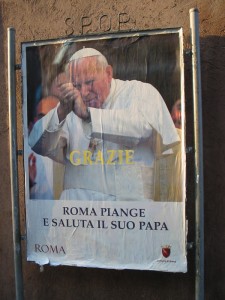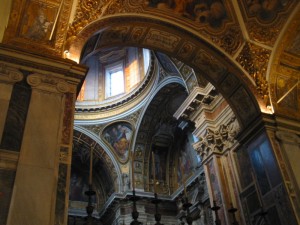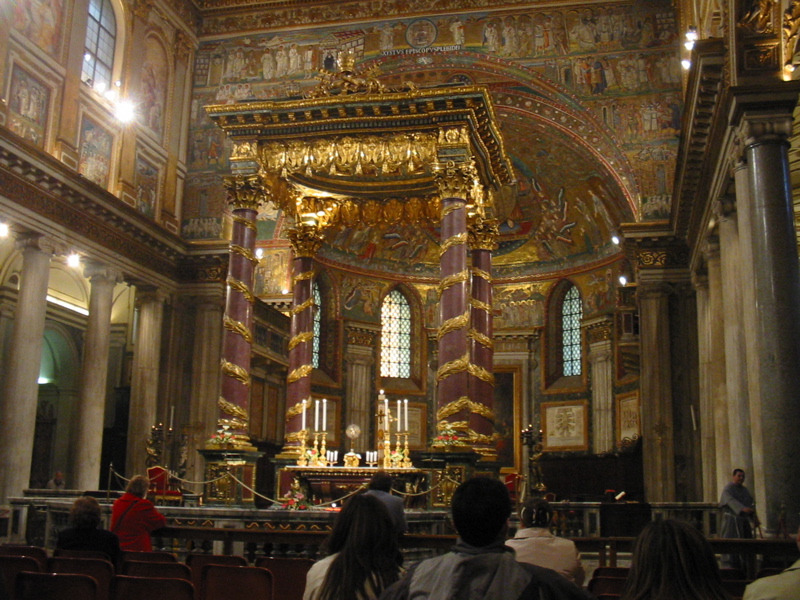O Rome! my country! city of the soul!
(Childe Harold’s Pilgrimage, George Gordon Noel Lord Byron, 1812)
Well, it turns out there are a few little bits from the previous episode that need to be cleaned up before we move on. So let’s get started, shall we?
The last little bits of Day Four

Francine had the only key, so I was a little unsure of how exactly I was going to get back into the flat. It turns out I needn’t have worried. As I was walking up to the door, Francine stuck her head out of our third floor window to greet me.
She had food on the table, bless her.
A brief note about Roman embalming
I’m not sure why it is in the United States our embalmers try so hard to get corpses to look lifelike. When I attended my Grandfather’s funeral some years ago, I was really kind of surprised at how good he looked.
This they do not do in Rome, or at least, this they did not do to the Pope.
He was very clearly dead. His skin was pale and drawn; his face looked almost skeletal it was so pallid. There could be no doubt. If you saw him, you knew. He was dead. D-E-A-D. Dead.
Of course, if you look at the cover of the issue of Newsweek for that week, you would see that they PhotoShopped the corpse. That’s right: virtual embalming.
Only in America.
Moving on now to the Borghese
Despite utter exhaustion, we had to get up early the next day. We had tickets, you see, to the Borghese Gallery. The Borghese is a peculiarly Roman institution. It contains some of the greatest sculpture and painting to be found anywhere in the world, including a great deal of Bernini’s more “mobile” sculpture.
Note: By mobile I mean “capable of being moved with great effort and great expense”. This is as opposed to immobile, meaning “providing architectural support to an immense building, probably a church or palace”. Bernini’s largest work is the colonnade surrounding Piazza San Pietro, consisting of 300 doric columns some 95 feet high and topped by larger than life-sized statues of Bernini’s 108 favourite saints.
The Borghese collection was originally gathered by a Renaissance Cardinal. It’s still in his villa, though the place has been museum-ised obviously. I mean, I’m pretty sure that Cardinal Borghese didn’t have a gift shop in his basement originally.
The thing is, you’ve got to make an appointment to see the collection.
They only let in a certain amount of people at a time. You’ve got two hours, and then they shoo you out. If you’re not there to collect your tickets on time, they sell them.
Our time slot was 9:00 to 11:00, meaning we had to be there at 8:30 to pick up our tickets or they’d be sold to the first person walking up sans reservation. It all made some sort of sense when I’d made the reservations back in February, I swear.
So there we were at the Cavour metro station at 8:00, bleary-eyed and fortified with caffeine. Cavour is on the B line and Borghese is on the A line, so we had to make a transfer at Termini.
And here, my friends, our woes began. In addition to going to Borghese, the A line goes to the Vatican.
The Rome Metro, as you will recall from a previous entry, is stupid crowded at the best of times. Today however, the day after the Pope’s lying-in-state began, I began to understand what the mediaeval chroniclers might have meant when referring to Mongol “hordes”.
There were volunteer security people from all over Italy, and they wouldn’t let us onto the platform. It was so crowded, they were afraid that somebody might get jostled onto the tracks.
It was only at this point that I truly began to realize the magnitude of what was going on.
With nowhere to go, and the B line trains continuing to dump unsuspecting tourists and ordinary commuters at Termini station, the stairways and corridors of the station rapidly filled up. So now, in addition to wall-to-wall people on the A line platform, we had wall-to-wall people backed up all the way to the B line platform. And still, the people were coming.
Clearly, something had to give. The Metro officials put every train at their disposal into service on the A line. How they managed the scheduling, I’ve no idea, but trains were coming every two minutes. It was barely enough to keep up with the constant flow of people.
The train we finally entered was dark and empty when it pulled into the station. As fast as we could scramble aboard, it was so full they had trouble closing the doors. When we got off at Borghese station, it was like being squeezed out of a toothpaste tube.
The Borghese is set amidst a vast park. It’s beautiful, but sadly I have no pictures. My camera hadn’t come through the previous day with functioning batteries, and there was no time to get new ones. I’m sure Francine will post some… hopefully she’ll include one of the giant equestrian statue of King Umberto. I was sort of obsessed with getting a decent photo (using her camera) of ole Humbert.
The wooded area immediately around the statue was littered with condom wrappers; apparently Humbert is more popular now than he was during his brief reign.
The sheer amount and variety of art at the Borghese is overwhelming, and I really doubt that twenty hours, never mind two, would be enough to take it all in. Take a look at the web site to get an inkling.
Always a bridesmaid
During the previous several days, we’d met up with Francine’s cousin Leone any number of times. Always we met in the same place, the Piazza Maria Santa Maggiore. Up to this point, we’d never actually made it into the enormous basilica looming over the piazza.
This afternoon, we would finally go in.
Now, Rome has dozens of churches, maybe hundreds. There’s a church on practically every street sooner or later. Some of them are tiny (like little San Lorenzo down the block from our flat), some of them are enormous (like the Pantheon), but only four of them are what they call Patriarchal Basilicas.
They are: St. Peter’s in the Vatican (the largest church in the world, thankyouverymuch), St. Paul’s Outside the Walls (where the body of St. Paul resides, minus his head), St. John Lateran (the Pope’s episcopal seat), and Santa Maria Maggiore. The one thing they all share in common (other than their basilica floor plan) is their scale.
Simply, they’re all frickin’ huge.

It’s a time machine built of beauty.
The great sculptor Bernini, the man who invented the baroque, is buried within the church. Ironically, though other tombs in the building are decorated with the best sculpture the builder could manage, Bernini’s tomb is marked only with a simple plaque on the floor.
All in all, a relatively easy day. Obviously, that won’t last.

The apse mosaics date to the IVth or Vth century; the ones in front are a millennium later.
On to Six! Et cetera!